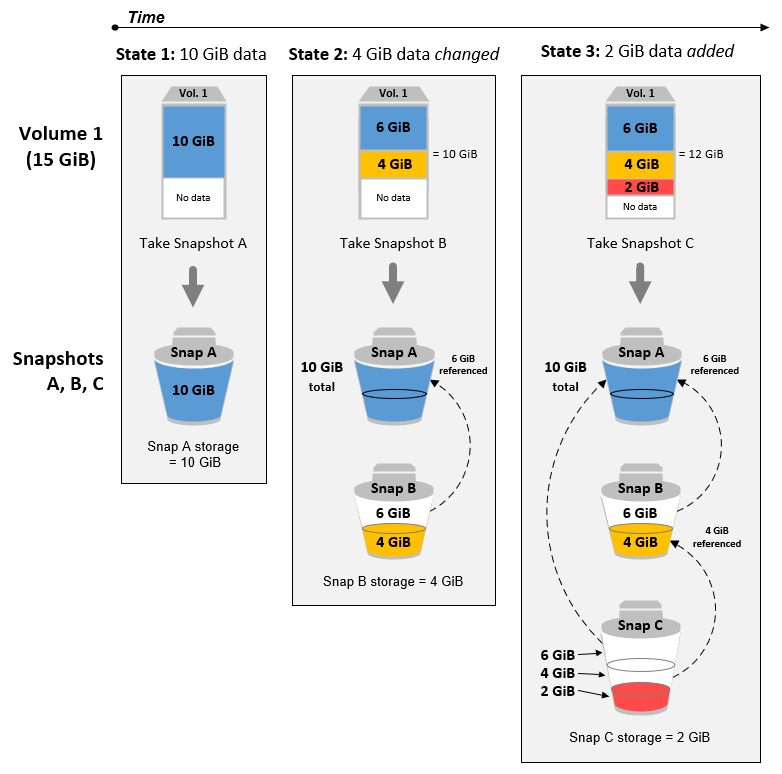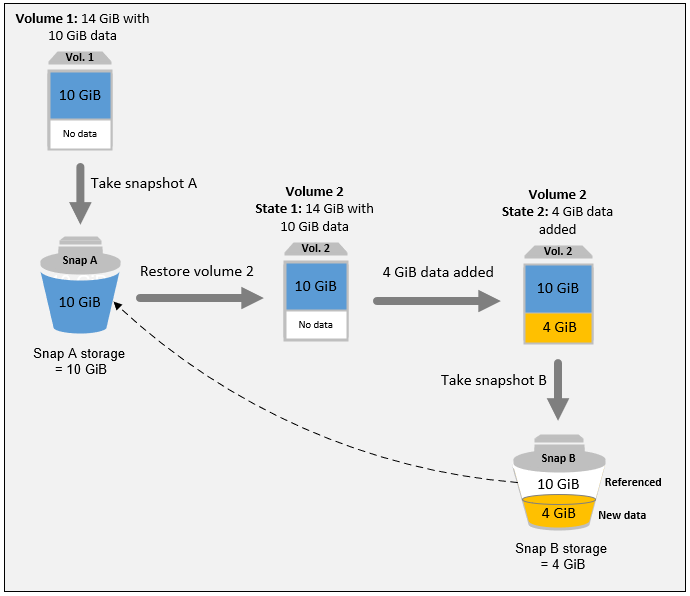How Amazon EBS snapshots work
The first snapshot that you create from a volume is always a full snapshot. It includes all of the data blocks written to the volume at the time of creating the snapshot. Subsequent snapshots of the same volume are incremental snapshots. They include only changed and new data blocks written to the volume since the last snapshot was created
The size of a full snapshot is determined by the size of the data being backed
up, not the size of the source volume. Similarly, the storage costs associated
with a full snapshot is determined by the size of the snapshot, not the size of
the source volume. For example, you create the first snapshot of a 200 GiB
Amazon EBS volume that contains only 50 GiB of data. This results in a
full snapshot that is 50 GiB in size, and you are billed for
50 GiB snapshot storage.
Similarly, the size and storage costs of an incremental snapshot are determined
by the size of any data that was written to the volume since the previous snapshot
was created. Continuing the previous example, if you create a second snapshot of the
same 200 GiB volume after changing 20 GiB of data and adding
10 GiB of data, the incremental snapshot is 30 GiB in
size. You are then billed for that additional 30 GiB snapshot storage.
For more information about snapshot pricing, see
Amazon EBS pricing
Important
When you archive an incremental snapshot, it is converted to a full snapshot that includes all of the blocks written to the volume at the time that the snapshot was created. It is then moved to the Amazon EBS Snapshots Archive tier. Snapshots in the archive tier are billed at a different rate from snapshots in the standard tier. For more information, see Pricing and billing for archiving Amazon EBS snapshots.
The following sections show how an EBS snapshot captures the state of a volume at a point in time, and how subsequent snapshots of a changing volume create a history of those changes.
Multiple snapshots of the same volume
The diagram in this section shows Volume 1, which is 15 GiB in size,
at three points in time. A snapshot is taken of each of these three volume states. The
diagram specifically shows the following:
-
In State 1, the volume has
10 GiBof data. Snap A is the first snapshot taken of the volume. Snap A is a full snapshot and the entire10 GiBof data is backed up. -
In State 2, the volume still contains
10 GiBof data, but only4 GiBhave changed after Snap A was taken. Snap B is an incremental snapshot. It needs to back up only the4 GiBthat changed. The other6 GiBof unchanged data, which are already backed up in Snap A, are referenced by Snap B rather than being backed up again. This is indicated by the dashed arrow. -
In State 3,
2 GiBof data have been added to the volume, for a total of12 GiB, after Snap B was taken. Snap C is an incremental snapshot. It needs to back up only the2 GiBthat were added after Snap B was taken. As shown by the dashed arrows, Snap C also references the4 GiBof data stored in Snap B, and the6 GiBof data stored in Snap A. -
The total storage required for the three snapshots is
16 GiBtotal. This accounts for 10 GiB for Snap A, 4 GiB for Snap B, and 2 GiB for Snap C.

Incremental snapshots of different volumes
The diagram in this section shows how incremental snapshots can be taken from different volumes.
-
Vol 1, which is
14 GiBin size, has10 GiBof data. Because Snap A is the first snapshot taken of the volume, it is a full snapshot and the entire10 GiBof data is backed up. -
Vol 2 is created from Snap A, so it is an exact replica of Vol 1 at the time the snapshot was taken.
-
Over time,
4 GiBof data is added to Vol 2 and the total size of its data is14 GiB. -
Snap B is taken from Vol 2. For Snap B, only the
4 GiBof data that was added after the volume was created from Snap A is backed up. The other10 GiBof unchanged data, which is already stored in Snap A, is referenced by Snap B instead of being backed up again.Snap B is an incremental snapshot of Snap A, even though it was created from a different volume.
Important
The diagram assumes that you own Vol 1 and Snap A, and that Vol 2 is encrypted with the same KMS key as Vol 1. If Vol 1 was owned by another Amazon account and that account took Snap A and shared it with you, then Snap B would be a full snapshot. Or, if Vol 2 was encrypted with a different KMS key than Vol 1, then Snap B would be a full snapshot.

For more information about how data is managed when you delete a snapshot, see Delete an Amazon EBS snapshot.